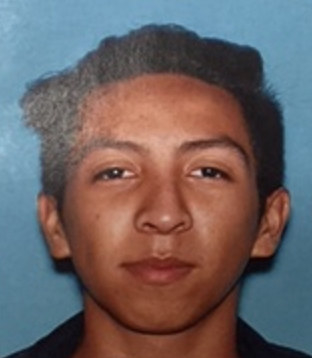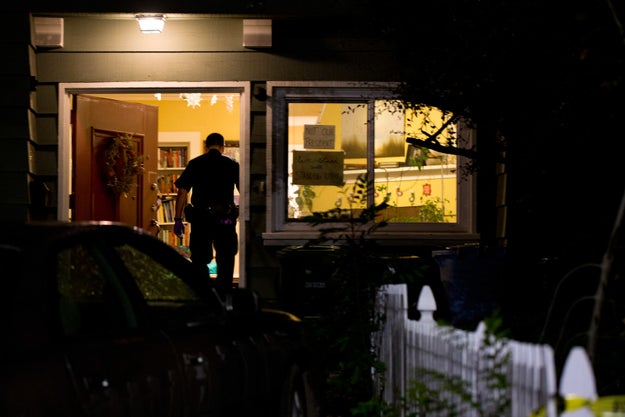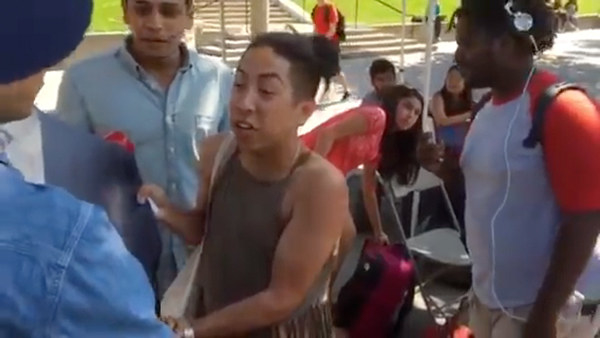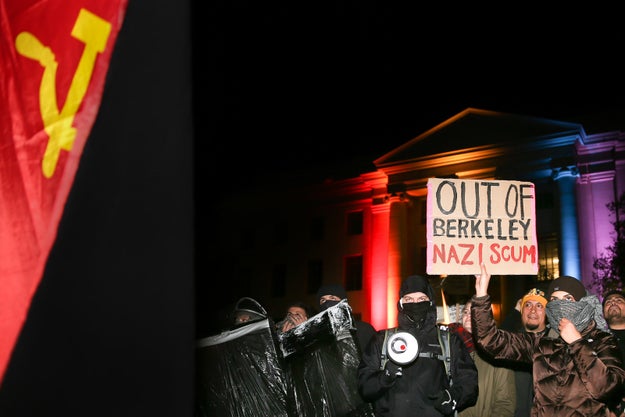[ad_1]
On Feb. 1, Pablo Gomez Jr. had what appeared to be a breakdown in court. Following a meeting with an Alameda County public defender, the 22-year-old murder suspect was dragged out of the courtroom by a flurry of grunting deputies, slender limbs flailing in red scrubs, while screaming: “Get off me,” “Stop,” “Ah!” Many of Gomez's friends and family members in the back of the gallery cried, their chairs creaking with each sob.
Pablo Gomez is a student activist at the University of California, Berkeley — a senior majoring in Chicano/Latino studies. Gomez has advocated for climate change education, organized for survivors of sexual assault, and supported Black Lives Matter, once helping to shut down a freeway to protest the police. But as of Jan. 6, Pablo Gomez is also an accused murderer, suspected of stabbing two women, one of whom died. The murder of Emilie Inman, a 27-year-old artist and teacher, was later described by police as “very brutal and very unusual.”

Pablo Gomez Jr.
Courtesy BPD
Maybe you read about Gomez on Ann Coulter’s Facebook. Maybe you saw the hashtag #BLMSlashing. Because when news began to spread in early January of the ghastly crime, it wasn’t the charges that propelled Gomez’s name from local news blurb to the most far-right corners of the internet. It was Gomez’s identities — activist, queer, person of color — that drove the outrage.
The crime caught Coulter and company's attention, but what fueled their brief yet intense fascination was Gomez, who became, as one commenter put it on an Oregon college sports message board — because that’s how far this story of a Berkeley murder traveled — “the perfect leftist perp.” Coverage of the crime turned into debate about whether Gomez had the right, as an alleged murderer, to be referred to by the gender pronoun “they.” Details of the crime and victims gradually dissipated, absorbed into the far-right's platform (filed under: violent social justice warriors).
Crimes committed by ideologues like Gomez have long been used by opposing political sides to further their agendas. But the fervor around Inman’s death, and Gomez’s pronoun, is different. It reflects not just the ability of the new online right to swiftly hijack a local tragedy to make a point, but also its omnipresence, its ability to penetrate and rattle one of America’s most liberal communities. Gomez and Inman’s story is the story of Berkeley, a progressive paradise where cracks were revealed by Donald Trump’s election — with the help of a jackhammer named Milo Yiannopoulos and a stampede of protesters — and where those fissures continue to be revealed in surprising ways.
It was Gomez’s identities — activist, queer, person of color — that drove the outrage.
Berkeley’s first homicide of 2017 began on a Friday, at the uncommon criminal hour of 11:40 a.m., with a 911 call that reported a 21-year-old woman needed help on Ridge Road, a block north of UC Berkeley’s campus. The woman had been stabbed.
According to unconfirmed scanner audio on Broadcastify, the woman told police she’d been stabbed south of campus, at a house on Ashby Avenue, then dropped off on Ridge Road. She named her assailant as Pablo Gomez, a fellow Berkeley student who, it later appeared, had once been her friend. An officer shared Gomez’s description with dispatch: “Hispanic male, twenties, gray shirt, dark gray pants, has kitchen knife that he took from someone’s house … According to the victim, the suspect is still in the area.” Later, “buzzcut” and “5-foot-4 thin build” were added to the description. Gray shirt became gray sweatshirt, and 5-foot-4 became 5-foot-6. Gomez’s name and description weren’t yet made public.
While the woman was taken to the hospital, police went to the address she provided. Hours later, they found another woman, stabbed to death.
The house on Ashby Avenue is unusual, even on the kind of picturesque, lush Berkeley block where every house is visually distinct. Look beyond the lopsided signs in the windows (Not Our President, Stand With Standing Rock, Black Lives Matter) and it’s a child’s drawing of a house, squat and A-frame, with a little chimney and a white-picket fence and an enormous red door — a door the width of two doors. When police arrived, that door was wide open.
“Stabbings are not uncommon, per se, but with this type of violence, it is uncommon.”
“It was clear,” police said in a community alert, “a violent crime had occurred there.” Later, they added “a significant amount of blood was found in certain parts of the property.”
No one was home when police arrived. There was only a gray sedan in the driveway, registered to Emilie Inman. Officers began searching the property. That evening, around 8:30 p.m., the local news website Berkeleyside published a story reporting Inman was missing; friends and family hadn’t heard from her since that morning and were worried.
Around 11 p.m., almost 12 hours after the first 911 call, Inman was found dead in the house with the red door. Police have released few details about the circumstances of her death. Berkeley Police Capt. Ed Spiller only told the local Fox affiliate that “it was very brutal and very unusual. … Stabbings are not uncommon, per se, but with this type of violence, it is uncommon.”
Inman was a French-born folk singer, a student at the Bay Area Center for Waldorf Teacher Training, and a graduate of UC Santa Cruz. Her degree was in environmental studies, which she used as a nature instructor for kids. Inman’s friends would later use phrases like “walking artwork” and “intoxicatingly liberated” to describe her. In some photos they shared, her long auburn hair was styled into thick dreadlocks; in others, it was short and curly, peeking out from beneath a hat.
Shortly after Inman’s body was found, police named Gomez as a homicide suspect, who was armed and dangerous, and urged Berkeley residents to call with any information about Gomez’s whereabouts. They said Gomez reportedly “shaved his head, which may have been done in an effort to alter his appearance.”

Police on the scene at Emilie Inman's home early on Saturday, Jan. 7.
Emilie Raguso / Via berkeleyside.com
Emilie Raguso decided to drive around that night. The Berkeleyside senior reporter — a 38-year-old longtime local journalist, a graduate of UC Berkeley’s journalism school, and the only full-time reporter on Berkeleyside’s staff — had been following the story all day from her desk: making calls to police sources, piecing together events using hours of scanner audio, posting updates to a Berkeley community Facebook group. Her first story that day — when the only known victim was the 21-year-old stabbing survivor on Ridge Road — was published two and a half hours after the late-morning 911 call, breaking the news of the stabbing.
Much later, after reporting that a body had been found on Ashby Avenue, Raguso went to see the still-active crime scene. She took some photos and talked to a police officer. She watched as a carousel of officers went in and out of the house, and as police began taking down some yellow tape around 1:30 a.m. — otherwise nothing noteworthy, she said. But after leaving the scene, she got a message from a woman who had seen Raguso’s posts in the UC Berkeley Facebook group. The woman said she knew Gomez through the campus activism community and that Gomez used the gender pronoun “they,” rather than “he.”
“I was looking and I was driving and I was like, ‘Holy shit, I don't want to be misidentifying Pablo,’” Raguso said. “‘I need to change this right away.’”
Raguso trusted the woman who wrote to her, but to ease her mind, she talked to a source at the Berkeley Police Department, who confirmed the pronoun, she said. Raguso changed “he”s to “they”s and added one line: “A friend contacted Berkeleyside after publication to say that Gomez Jr. uses the pronoun ‘they.’” Raguso didn’t include the name of the friend who sent the tip. The woman didn’t ask for anonymity, but Raguso said she didn’t want to “put her on blast.”
“And I’m glad I didn’t,” she said. If Raguso had included her name, the woman would have likely been caught in the same hurricane of criticism that swept up Raguso, spinning the Gomez story wildly away from Berkeley and splat-landing it in the most raw, politically heated, no-holds-barred corners of the internet.
The tweets began taking off the morning of Jan. 7, five hours after Raguso updated the pronouns and five hours before Gomez’s arrest. Tim Groseclose, a George Mason University economics professor, shared a link to Berkeleyside’s story: “UC Berkeley student wanted for murder, calls himself ‘they’. They is [are?] a Chicanx/Latinx studies major.” Two hours later, the professor dug up a photo of Gomez smiling with California Gov. Jerry Brown and Democratic donor Tom Steyer.
“Was They motivated by hatred of whites, the female sex, heterosexuals, or what?”
The politicization was instantaneous. But it wasn’t just right-wing spectators shaking their heads at a murder allegedly committed by someone on the left. These spectators, ranging from conventionally conservative to full-on alt-right, implied Gomez’s motive for the murder was left-wing beliefs. Ann Coulter tweeted a similar thread to the professor’s, adding “This homicide sounds more like BLM” (Black Lives Matter). Prominent right-wing blogger Mike Cernovich called Gomez “another violent criminal on the left. These are feral ‘people,’ prone to violence. Avoid!”
Gomez’s old tweets about white people began surfacing in Twitter circles where Coulter and Cernovich reigned. “Why the fuck do white people always think they’re the victims do you not understand you are the world’s #1 perpetrators,” Gomez tweeted in March 2014. Two years later: “i believe (white) ‘america’ is still a young twisted fantasy too evil for fruition.” Inconsequential Twitter exchanges with Black Lives Matter leader DeRay Mckesson became smoking guns.
With Gomez’s social media mostly public, there was plenty to see of the “nonbinary, pan xicanix who loves dr pepper.” There was Gomez talking climate change in a Vice News video. There was Gomez fighting with Sweetgreen on Twitter about the salad restaurant printing “Make America Healthy Again” on its menus. There was a video of Gomez trying to take a Donald Trump cardboard cutout from a College Republicans booth on campus — a 14-second clip with “vandalize” and “assault” in the title that didn’t quite appear to show either.

Gomez Jr. (center)
Refined Right / YouTube / Via youtube.com
There was Gomez making jokes, tweeting GIFs, posting selfies with friends and screenshots from Jack’d, a dating app. Not everything was about activism, but a lot of it was.
By the evening of Jan. 7, Gomez’s story had been picked up by GotNews — the brash doxxing website popular among the online right — which characteristically published screenshots of Gomez’s Facebook page, including one in which they voiced support to abolish the police, and to “transform every structure that is posioned [sic] by a toxic whiteness that threatens Black lives every day.” GotNews also pointed to a quote Gomez reblogged on Tumblr in defense of looting.
“It’s unclear,” the GotNews story read, “if Gomez’ far-left ‘social justice’ justification of looting — a violent, criminal act — played a role in justifying Gomez’ alleged murder.”
The Unz Review’s Steve Sailer later raised similar questions about Gomez’s motive (with a dramatic emphasis on pronouns). “How much evidence is there that They’s stabby outburst consisted of hate crimes?” Sailer wrote. “Was They motivated by hatred of whites, the female sex, heterosexuals, or what?”
As awareness of Gomez’s case spread, picking up coverage from the Daily Caller, Breitbart, and the Weekly Standard — and smaller websites like the Other McCain, MagaFeed, Red State Watcher, and the Gateway Pundit — more stories began taking on this just-asking-questions tone. Did Gomez kill Emilie Inman because they hated white people, or was it because Gomez was a “social-justice warrior,” who everyone knows are violent, “feral ‘people?’” Just asking questions.
All partisans are drawn to certain narratives. For the online right, one favorite narrative is the story of a nonwhite criminal committing violence against a white victim. They comb through national news for stories like these — stories that provoke emotion in everyone, regardless of political beliefs. A brutal crime and tragic death in a college town, for example. If that story also promotes a piece of the far-right agenda, like the proliferation of minority violence, they spread it, rearranging the facts for shocking emphasis. (And they do generally deal in facts, however selectively chosen; there’s nothing “fake news” about this phenomenon.) In Gomez’s case, that might mean emphasizing in headlines or tweets that the murder suspect was an activist or queer. But the heart of their retelling of the crime will always be race.
That’s how Gomez’s story became #BLMSlashing, a sequel to #BLMKidnapping, tied to Black Lives Matter by the online right. #BLMSlashing appeared to begin with Paul Nehlen, the Republican businessman who tried to oust Paul Ryan in 2016 as a further-right candidate for Congress. It was picked up by hundreds of others — someone claiming to be a former Trump campaign staffer, an alt-right-endorsing firearms dealer, users with the occasional “#MAGA” or “deplorable” or “pro-white” in their Twitter bios — many pointing out how the mainstream media wasn’t covering the double stabbing.
After a few days, the Twitter pundits moved on. Just a handful of conservative outlets have continued to followed Gomez’s case. One of the only writers who covered Gomez’s apparent breakdown at the arraignment was Sailer, of the Unz Review. His take, citing a report that Gomez had scratched one of the deputies’ hands in the scuffle: “Berkeley activist Pablo ‘They’ Gomez assaults deputies in courthouse.”

The protest against Milo Yiannopoulos at UC Berkeley.
Elijah Nouvelage / Getty Images
Something else happened on Feb. 1, the day Gomez was ejected, kicking and screaming, from the courtroom. That evening, Milo Yiannopoulos was scheduled to speak on campus at the invitation of the Berkeley College Republicans. Instead Yiannopoulos was removed from UC Berkeley before his speech, chased off by protesters who had launched a night of destruction, lighting fires on campus and smashing storefront windows on campus-adjacent blocks.
Late into the night, it became clearer that most of the masked and baseball bat–armed protesters weren’t Berkeley students. But many Berkeley students were still around, holding up signs calling for safe spaces for queer people, broken glass crunching under their sneakers as Rihanna blasted from some distant portable speaker. It wasn’t hard to imagine that Pablo Gomez, seasoned campus protester, would have been among these students, if Gomez weren’t in jail on murder charges.

Elijah Nouvelage / Getty Images; Tayfun Coskun / Anadolu Agency / Getty Images
[ad_2]
